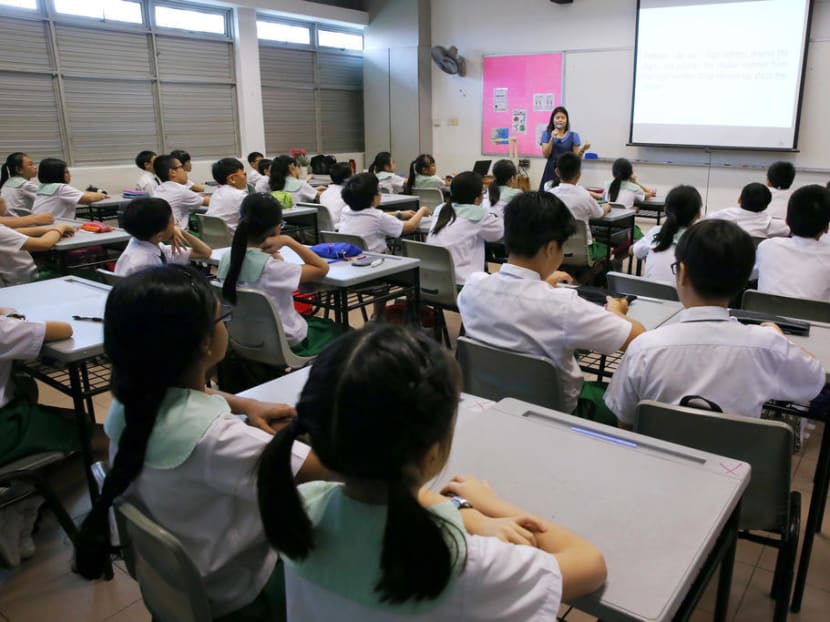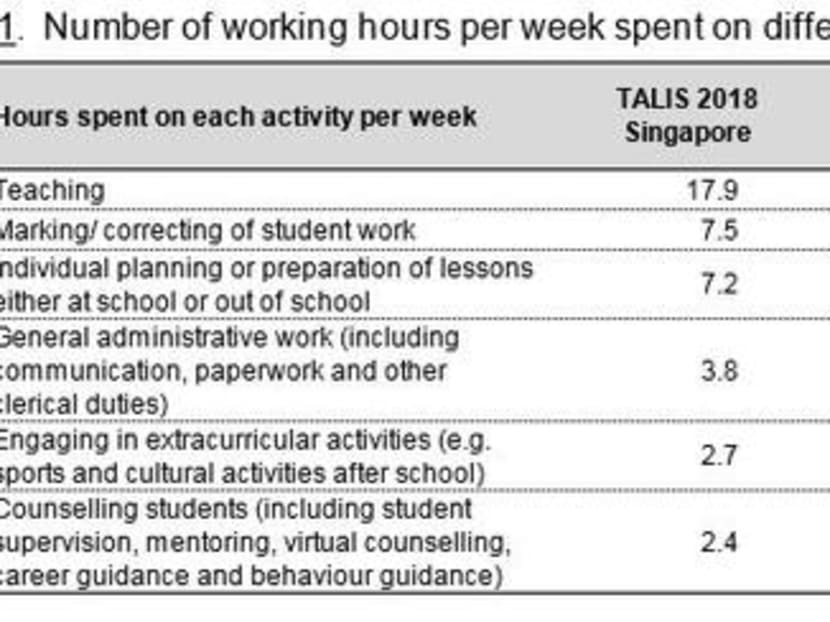Singapore teachers working fewer hours, but still more than international peers: OECD survey
SINGAPORE — Teachers here are working about two hours less a week than five years ago, but are still clocking in more time than their international peers, a major global survey found.

The global survey of schools found that Singapore teachers are now working fewer hours than they were in 2013 though some teachers here dispute this finding.
SINGAPORE — Teachers here are working about two hours less a week than five years ago, but are still clocking in more time than their international peers, a major global survey found.
The survey, published on Wednesday (June 19), showed that Singapore teachers work 46 hours on average every week, of which 18 hours are spent on teaching, with the rest spent on other work such as administrative matters and school activities.
It is the second time that Singapore has taken part in the five-yearly Organisation for Economic Co-operation and Development (OECD) Teaching and Learning International Survey, which was last done in 2013. The OECD is an intergovernmental body representing 36 developed economies, though the survey extended beyond its member countries.
The 2018 report showed that Singapore teachers’ working hours are slightly shorter than their working hours in the 2013 report, which were at 48 hours a week. They are also teaching one more hour a week than the 17 hours in the 2013 report.
Speaking to reporters after a briefing on Wednesday, Mr Wong Siew Hoong, director-general of education from the Ministry of Education, attributed the change largely to a reduction in administrative work.
However, the teachers are still working longer hours than their counterparts in other countries, who clocked in an average of 39 hours a week, the survey showed. In 2013, the international average was 38 hours.
And globally, even though they work fewer hours overall, teachers are engaged in teaching for 21 hours on average — three more hours a week than teachers in Singapore.
The survey was first conducted in 2008 and is done every five years. This year the number of countries taking part rose from 33 to 48 and polled more than 250,000 teachers. A total of 3,280 lower secondary school teachers from 157 secondary schools and a random selection of 12 private schools in Singapore were surveyed.
The education systems involved in the survey included those from Australia, Britain, China, Denmark, Finland, France, Italy, Japan, Russia, Shanghai in China, the United States and Vietnam.
Here are the key findings from the report:
SHORTER HOURS FOR TEACHERS
The OECD survey showed that for teachers here, time spent on administrative work fell from 5.3 hours a week in 2013 to 3.8 hours last year. However, it is still higher than the international average of 2.7 hours.
Similarly, there was a drop in the time set aside for marking — from 8.7 hours in 2013 to 7.5 hours last year. Still, this is significantly higher than the international average of 4.2 hours.
What teachers say: Four teachers teaching the lower secondary level, who spoke to TODAY on the condition of anonymity as they were not supposed to speak to the media, said that they did not feel their working hours have been reduced.
Most of their time is spent on administrative work, planning lessons as well as co-curricular activities and other school activities, they added.
Those interviewed said that they clock from 47 hours to more than 52 hours a week, taking into account the hours spent on some Saturdays due to co-curricular activities.
A teacher in his 30s at Temasek Secondary School said that he works on average 9.5 hours a day and some half-days on Saturdays. “Administrative work takes up a substantial part of my time, but I’m not bogged down by it,” he said. “Some of the administrative processes are beginning to be digitalised, so, not too bad.”

However, another teacher at Commonwealth Secondary School, who is in her 20s, suggested that the survey makes a “wrong” assumption that teachers here do not spend more time teaching compared with their peers in other countries.
“We spend a lot of time planning lessons, trying to introduce creativity and innovation in the classrooms and that helps a lot with learning,” she added.
“Teachers in other schools might spend more time teaching, but not necessarily invest time in coming up with such lesson plans. So, when it comes to teaching, it’s important not just to look at the hours, but other factors taking place outside the classroom.”
What MOE says: Touching on the shorter working hours, Mr Wong told reporters: “This is indeed gratifying to know, because the ministry has put in quite a number of initiatives to try and reduce teachers’ administrative workload. “For example, in terms of attendance marking (and) in terms of the consent form that is necessary when they want to take the students out on learning journeys.”
TEACHING STUDENTS WITH SPECIAL NEEDS
More than a third of Singapore teachers — or 35 per cent — surveyed have undergone training to teach students with special needs, significantly higher than the 23 per cent figure in the 2013 survey.
There was also an increase in teachers expressing the need for such training, from 15 per cent in 2013 to 20 per cent last year.
These figures though, are lower than the international average, where 43 per cent have undergone training in the area, while 22 per cent said that they want such training.
The OECD report stated that, on average, 19 per cent of teachers here work in classes where at least 10 per cent of the students have special needs. This is markedly lower than the international average of 27 per cent.
For Singapore teachers, the need for training in the area comes as a growing number of such students enrol in mainstream schools, with the size having doubled from 13,000 in 2013 to about 26,000 last year.
In addition, 17 per cent of school principals reported that the “delivery of quality instruction in their schools is hindered by a shortage of teachers with competence in teaching students with special needs”, compared with 32 per cent across the other OECD countries.
What teachers say: Teachers interviewed said that as more students with special needs enter mainstream schools, teachers should be better trained to deal with their emotional and learning needs.
A teacher at Bukit Batok Secondary School said: “Helping them requires patience, and some of my peers I know, have said they are exasperated and at a loss on how to help them. If we want to be more inclusive, teachers have to get as much training in this area as we do in other areas.”
What MOE says: Describing the findings as “useful”, Mr Wong said that schools have become “increasingly inclusive” as there are more students with special needs taking up the mainstream curriculum. Teachers, he added, are also “trying their best” to effectively help such students.
“And the teachers, through the survey, have indicated the need for more professional development in these areas,” Mr Wong noted. “We have been doing this and we will be reviewing this to see what more professional development programmes our teachers can undergo to make them more effective teachers in supporting students with special needs.”
OTHER FINDINGS FROM THE SURVEY
Just like in the 2013 survey, Singapore teachers are markedly younger than their international peers. They are 38 years old, on average, compared with the international average of 44 in the 2018 report.
More than 95 per cent of the teachers surveyed here said that they joined the profession for two key reasons: Wanting to influence the development of children and contribute to society.
More than 95 per cent of teachers also said that they are “well-trained” in areas such as subject content, teaching pedagogy and classroom practice as part of their induction training. The figures in these areas are higher than the international average of between 88 and 92 per cent.
When it comes to equality and diversity in schools, all of the teachers here said that it is important to treat students from all socio-economic backgrounds equally. Students, they added, should learn that people of different cultures have a lot in common.
The survey also showed that 99 per cent of Singapore teachers organise multicultural events compared with the international average of 55 per cent.
Likewise, 98 per cent support activities or organisations that encourage students of diverse ethnic and cultural identities, while only 61 per cent of teachers from other countries do so.









